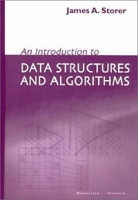| An Introduction to Data Structures and Algorithms артикул 12867d. |
 |
Data structures and algorithms are presented at the college level in a highly accessible format that presents material with one-page displays in a way that will appeal to both teachers and students The thirteen chapters cover: Models of Computation, Lists, Induction and Recursion, Trees, Algorithm Design, Hashing, Heaps, Balanced Trees, Sets озмьщ Over a Small Universe, Graphs, Strings, Discrete Fourier Transform Parallel Computation Key features: Complicated concepts are expressed clearly in a single page with minimal notation and without the "clutter" of the syntax of a particular programming language; algorithms are presented with self-explanatory "pseudo-code " Chapters 1-4 focus on elementary concepts, the exposition unfolding at a slower pace Sample exercises with solutions are provided Sections that may be skipped for an introductory course are starred Requires only some basic mathematics background and some computer programming experience Chapters 5-13 progress at a faster pace The material is suitable for undergraduates or first-year graduates who need only review Chapters 1-4 Chapters 1-4 This book may be used for a one-semester introductory course (based on Chapters 1-4 and portions of the chapters on algorithm design, hashing, and graph algorithms) and for a one-semester advanced course that starts at Chapter 5 A yearlong course may be based on the entire book Sorting, often perceived as rather technical, is not treated as a separate chapter, but is used in many examples (including bubble sort, merge sort, tree sort, heap sort, quick sort, and several parallel algorithms) Also, lower bounds on sorting by comparisons are included with the presentation of heaps in the context of lower bounds for comparison-based structures Chapter 13 on parallel models of computation is something of a mini-book itself, and a good way to end a course Although it is not clear what parallel architectures will prevail in the future, the idea is to further teachAlthough it is notclear what parallel architectures will prevail in the future, the idea is to further teach fundamental concepts in the design of algorithms by exploring classic models of parallel computation, including the PRAM, generic PRAM simulation, HC/CCC/Butterfly, the mesh, and parallel hardware area-time tradeoffs (with many examples) Apart from classroom use, this book serves as a good reference on the subject of data structures and algorithms Its page-at-a-time format makes it easy to review material that the reader has studied in the past. НаступаетISBN 0817642536. |